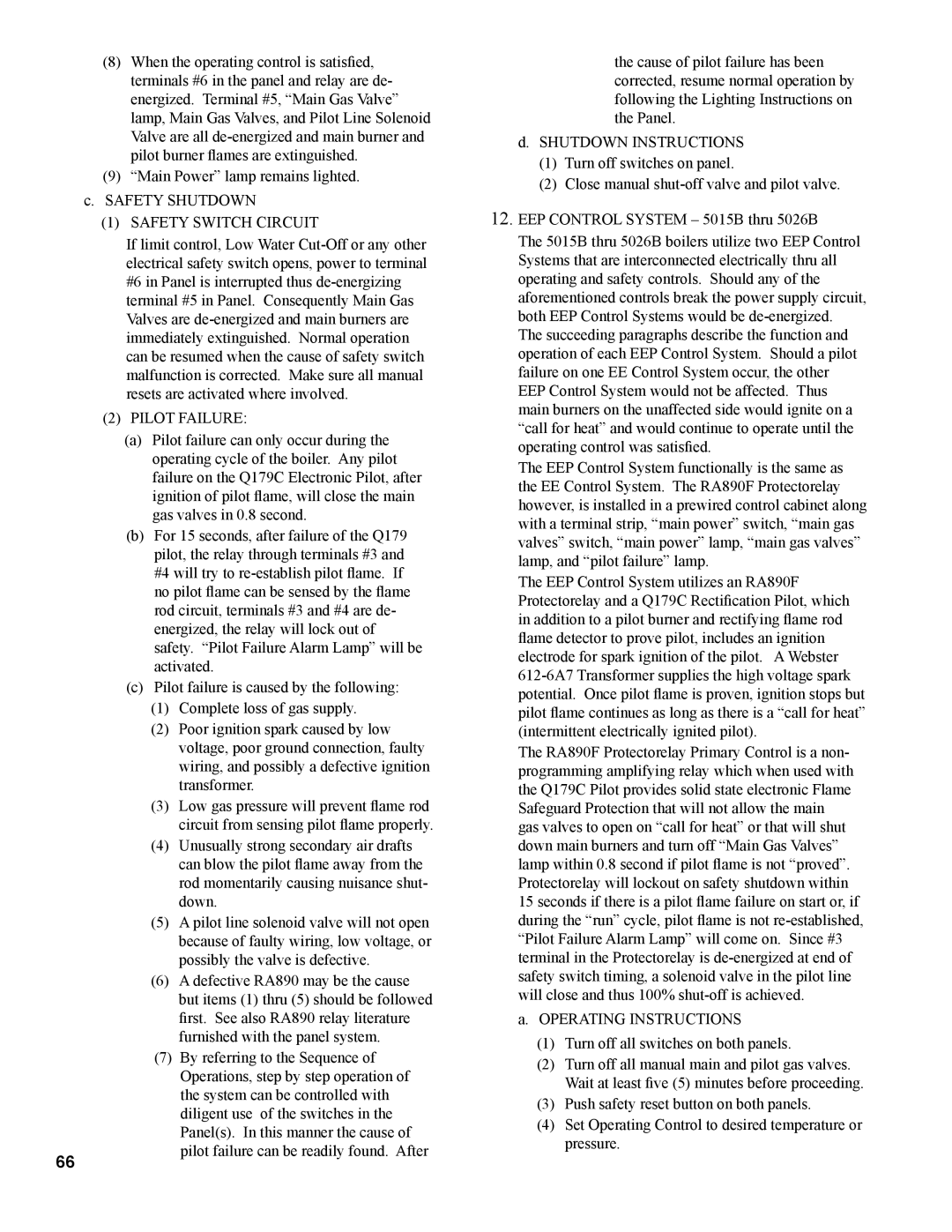(8)When the operating control is satisfied, terminals #6 in the panel and relay are de- energized. Terminal #5, “Main Gas Valve” lamp, Main Gas Valves, and Pilot Line Solenoid Valve are all
(9)“Main Power” lamp remains lighted. c. SAFETY SHUTDOWN
(1)SAFETY SWITCH CIRCUIT
If limit control, Low Water
(2)PILOT FAILURE:
(a)Pilot failure can only occur during the operating cycle of the boiler. Any pilot failure on the Q179C Electronic Pilot, after ignition of pilot flame, will close the main gas valves in 0.8 second.
(b)For 15 seconds, after failure of the Q179 pilot, the relay through terminals #3 and #4 will try to
(c)Pilot failure is caused by the following:
(1)Complete loss of gas supply.
(2)Poor ignition spark caused by low voltage, poor ground connection, faulty wiring, and possibly a defective ignition transformer.
(3)Low gas pressure will prevent flame rod circuit from sensing pilot flame properly.
(4)Unusually strong secondary air drafts can blow the pilot flame away from the rod momentarily causing nuisance shut- down.
(5)A pilot line solenoid valve will not open because of faulty wiring, low voltage, or possibly the valve is defective.
(6)A defective RA890 may be the cause but items (1) thru (5) should be followed first. See also RA890 relay literature furnished with the panel system.
(7)By referring to the Sequence of Operations, step by step operation of the system can be controlled with
| diligent use of the switches in the |
| Panel(s). In this manner the cause of |
66 | pilot failure can be readily found. After |
|
the cause of pilot failure has been corrected, resume normal operation by following the Lighting Instructions on the Panel.
d.SHUTDOWN INSTRUCTIONS
(1)Turn off switches on panel.
(2)Close manual
12.EEP CONTROL SYSTEM – 5015B thru 5026B
The 5015B thru 5026B boilers utilize two EEP Control Systems that are interconnected electrically thru all operating and safety controls. Should any of the aforementioned controls break the power supply circuit, both EEP Control Systems would be
The succeeding paragraphs describe the function and operation of each EEP Control System. Should a pilot failure on one EE Control System occur, the other EEP Control System would not be affected. Thus main burners on the unaffected side would ignite on a “call for heat” and would continue to operate until the operating control was satisfied.
The EEP Control System functionally is the same as the EE Control System. The RA890F Protectorelay however, is installed in a prewired control cabinet along with a terminal strip, “main power” switch, “main gas valves” switch, “main power” lamp, “main gas valves” lamp, and “pilot failure” lamp.
The EEP Control System utilizes an RA890F Protectorelay and a Q179C Rectification Pilot, which in addition to a pilot burner and rectifying flame rod flame detector to prove pilot, includes an ignition electrode for spark ignition of the pilot. A Webster
The RA890F Protectorelay Primary Control is a non- programming amplifying relay which when used with the Q179C Pilot provides solid state electronic Flame Safeguard Protection that will not allow the main gas valves to open on “call for heat” or that will shut down main burners and turn off “Main Gas Valves” lamp within 0.8 second if pilot flame is not “proved”. Protectorelay will lockout on safety shutdown within 15 seconds if there is a pilot flame failure on start or, if during the “run” cycle, pilot flame is not
a.OPERATING INSTRUCTIONS
(1)Turn off all switches on both panels.
(2)Turn off all manual main and pilot gas valves. Wait at least five (5) minutes before proceeding.
(3)Push safety reset button on both panels.
(4)Set Operating Control to desired temperature or pressure.
